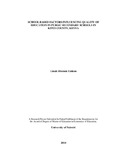| dc.description.abstract | The purpose of the study was to investigate the school based factors influencing the quality of education in public secondary schools in Kitui County. The study was guided by the following specific objectives; to determine how physical facilities affect the quality of education, to establish the extent to which staffing in public secondary schools is affecting the quality of education, to examine how the school fees charged by various categories of schools influence the quality of education, to determine to which extent class size affect the quality of education. The study was guided by human capital theory developed by Schultz in 1960. The study employed descriptive survey design. According to records held at the Kitui County director of education office, there are 16 districts in the county with 340 schools. Therefore the target population was all the 340 headteachers and 2065 teachers. Simple random sampling was used to ensure unbiasedness among the respondents, as the respondents were given equal chances of being selected to participate in the study. The study purposively selected all the 124 principals. The research instruments that were used for this study are questionnaires and observation schedules). A pilot study of four schools randomly selected with four principals, eight class teachers and twenty eight teachers were used. To test for the reliability of the questionnaire the researcher applied the test retest technique. Descriptive studies require meaningful description of a distribution of scores using a few indices or statistics. The study findings indicated that physical facilities affect the quality of education. It was clear that majority of the headteachers (76.5%) said that their libraries were inadequate. 70.6 percent of the schools sharing of facilities was not available. All the schools did not comply to fire and safety requirements on the toilets and classrooms, while the administration block was rated highly on compliance with the fire and safety requirements in majority of the schools followed by the laboratories, kitchen, library. Majority of the headteachers (58.8%) indicating breakages was one of the major problem encountered in effort to optimally utilize physical facilities, while congestion was rated second and misuse and low delivery being rated third respectively. 82.4% of the principals said the remedies to problems encountered in secondary schools make shift was the most common way of compensating for physical facilities that were not sufficient in schools. On effects of staffing on the quality of education in secondary schools, Girls’ schools were found to have better staffing with at least 3 (33.3%) schools having more than 25 teachers, 4 (44.5%) schools having between 21 to 25 teachers. On the effect of staff category on the quality of education in secondary schools, at least all schools have 66% and above of TSC deployed teacher. On the effects of fee charged on the quality of education in secondary schools with mixed day schools charge lower fees with the highest school charging within the range of 21,000 to 25,000 Kenya shillings. The effect of class size on the quality of education, one mixed day secondary school had a class with more than 200 students. Summary of trends of passing in grades was done for the four years consecutively. The study leads to a conclusion that physical facilities in the schools affect the quality of education. Lack of good condition buildings in the school will hinder offering of quality education in
xiv
schools. The study concludes that lack enough staff in schools led to poor quality of education. The study concludes that fees charged in secondary schools are high and as a result most of students are constantly send home. Head teachers were found to habitually send students for fees at least thrice in a term. This shows the much time students wastes to and from home in look for fees. The government funding through FDSE was found to be too low and needed to be increased in order to enable all students to stay in school. The study found class sizes to be high in most schools. Classes with students ranging up to 200 are likely to compromise efficiency in delivery. Improve the schools capacity building and planning to fully equip. Schools have BOM teachers constituting of almost a third of the whole staffing. The government should increase the funding through the FDSE programme. Headteachers should enrol students according to the resources and teachers they have to avoid overcrowding schools and overworking teachers. Headteachers should involve the community around them to aid in school development issues. Through the government, schools should come up with more classes and create streams to ease the burden of congestion in classes as has been witnessed in this study | en_US |

